Quake 2 2023 tech review: this is how to remaster a game
New features, new content and updated visuals at a great price.
I started playing Quake 2 over 25 years ago and today I'm still at it - thanks to a collaboration between Nightdive Studios, id Software and Machine Games that unleashes a new iteration of the classic shooter. This new re-release boasts a wide range of new content and features, but fundamentally it's designed to deliver the experience you remember. So let's break down the new features, the new content, the updated visuals and what you can expect on consoles and PCs alike.
Like every id Software release before it, Quake 2 made history. It was id's first game built with 3D accelerator cards in mind, it featured a rich and interconnected campaign unlike anything they'd built before, and it ushered in a burgeoning era of esports. Quake 2 introduces the Strogg - a nightmarish army of wire and flesh - and asks players to cross their home planet Stroggos to destroy their planetary defense system and assassinate their commander. Quake 2 is not a game rich in story, but it is the first id developed shooter attempting anything close to it. Unlike Doom or Quake, you'll traverse and re-traverse a series of interconnected maps - accomplishing an objective in one map can trigger an event or provide the necessary items to unlock the next area in a prior map.
Quake 2 is a PC game at its core, but past console conversions included versions for PlayStation, N64 and Xbox 360 - though the game wasn't available in a form fit for modern consoles before this release. Now it's available for the full gamut of contemporary platforms: PS4, PS5, Xbox One, Xbox Series, Switch and PC.
On each platform, you'll find a wide range of changes and improvements under the hood, designed to enhance the visuals and audio while staying true to the original presentation. These include major improvements to the light map system, liquid rendering, animation, and more. The 2023 release also features the original campaign, both expansion packs, the N64 version of the game and an entirely new episode created by Machine Games. All of this content is contained within a neatly organised menu system that feels like a refined extension of the original. There's even a museum of sorts, featuring development docs, trailers, artwork and even playable levels pulled from early pre-release demos such as the E3 1997 build of Quake 2.
Another strength of its menu lies in the graphics options - Quake 2 allows ful adjustment of visual features across every single platform, letting you tweak the game to your liking - even going so far as to approximate the look of the original software renderer with monochrome light maps and no texture filtering or enable a (pretty good!) CRT filter. The PC version allows you to customise the CRT simulation, including an additional shadow mask setting. In fact, there are hundreds of settings you can adjust in from the in-game console on PC which is always a pleasure.
Let's begin this analysis with a look at the 2023 release running on every console, comparing the the differences and performance, before we get into the visual differences and improvements alongside other tweaks and changes to the game.
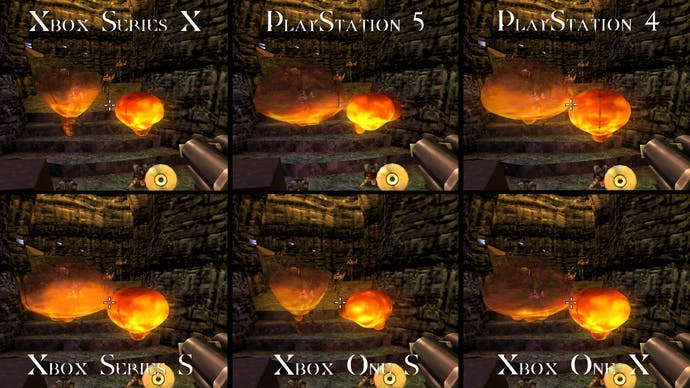
To start off then, Quake 2 basically supports the maximum resolution and frame-rate of each console - with dynamic resolution scaling to keep performance consistent. PS4, Xbox One and Switch all support 1080p at 60fps, One X and PS4 Pro deliver 4K at 60fps, and Series X and PS5 max out at 4K and 120fps. Xbox Series S also supports 120Hz, with internal resolutions between 1080p and 4K in this mode, while at 60Hz you get a largely 4K image.
You'll notice dynamic resolution scaling kicking in most often on last-gen consoles, whereas Series X and PS5 deliver the full-fat 4K experience at 120fps with few issues. Switch drops to 720p often in docked mode, sometimes as low as 540p, while PS4 Pro often drops closer to 1080p than Xbox One X, which delivers 4K much more often.
Performance is largely stable, especially on the current generation consoles where a locked 60fps or 120fps is basically guaranteed. Older machines, such as Switch, PS4 or the original Xbox One, do exhibit drops at points during the Machine Games campaign - due to its massive increase in enemy density and level complexity. This new campaign pushes way beyond anything in the original version of Quake 2, it should be noted, hence the drops. The setting which has the most significant impact on performance is motion blur, so disabling this can reduce drops and increase average resolution. Unfortunately, the Switch version doesn't use motion blur and therefore this isn't an option for the Nintendo console.
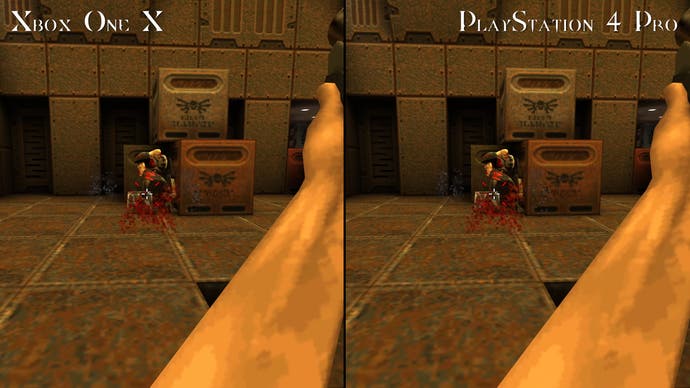
While differences do exist per platform then, the game is in great shape regardless. It's simply the case that newer machines allow higher fidelity and performance, as you'd expect. The real meat of this update lies in its visual enhancements and changes though, and while it may just look like Quake 2, you'll find many things have been improved under the surface. Bethesda posted a comprehensive blog covering these changes, so let's discuss some of these improvements.
The first major enhancement stems from the way lighting is handled. Light maps - precalculated texture maps applied to polygon surfaces representing lighting information - form the foundation of the original Quake's visuals, and with the transition to Quake 2, developer id Software implemented support for coloured light maps. These were baked during the compilation process, as PCs of this era were not fast enough to render the world lighting in real-time.
In this new version of Quake 2, light map resolution receives a 4x boost, achieved through a collaboration with two contributors to the famous ericw-tools project which adds graphical features to Quake 2 levels. The new baked light maps are higher density and can capture more of the environment, improving the perceived illumination and shadow detail. This is further improved through the use of Phong shading, which allows smoother shading of low-poly structures without altering the map data, and baked ambient occlusion, creating subtle contact shadows throughout the environment.
Liquid materials, such as water or lava, are also properly lit now. In the original, even in a darkened area of the map, water surfaces appeared at full brightness - but that has been changed and they now behave more as expected within the world.
Animated water has also been improved. In the original software renderer, textures marked as fluids could be animated through cleverly manipulating the x/y values of the texture's surface, but early 3D accelerator cards couldn't perform this operation and relied on simple vertex manipulation instead. Modern GPUs have no such issue though, so the 2023 version now display water surface textures like an even smoother version of the software renderer, which looks great.
When you go below the waterline, the entire screen is warped too, another impossibility on older graphics cards that's been adapted from the N64 version of Quake by Sam Villareal, the lead programmer of Nightdive's Kex engine.

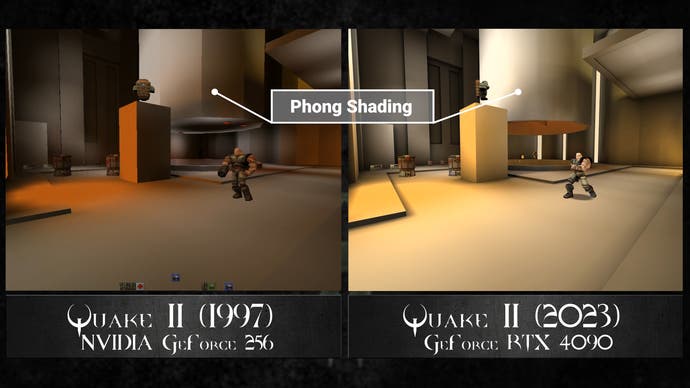
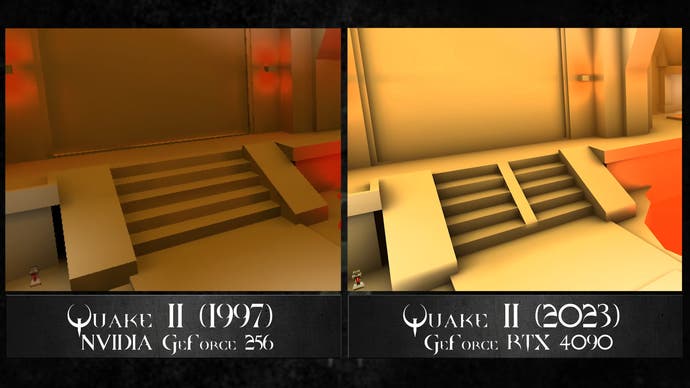
Then there are the dynamic lights. Quake 2 was known for its dynamic, colourful lighting - fire the blaster and you're treated to a light show that was absolutely dazzling at the time. However, the original game's approach showed obvious artefacts, due to its low resolution dynamic light map, but here we have a per-pixel lighting solution that produces a smooth falloff around each burst of light - with proper shadows thanks to the new shadow map system, which is a nice bonus. These real-time projected shadows help to further ground dynamic objects in the game world.
Even better, the developers have added muzzle flash textures to weapon fire - the combination of muzzle flash, shadows, and improved dynamic lighting really enhances the visual presentation. This is further enhanced by the addition of light volumes, which were introduced in Quake 3 Arena. This is basically a 3D grid which samples light maps during the compilation process. By referencing this light grid, dynamic objects can now be appropriately lit and coloured. This means that enemies are influenced by the world lighting, in a way that wasn't possible in the original version of Quake 2.
Two additional atmosphere-enhancing features are glow maps and height fog. Glow maps are basically a texture mask which defines whether a surface should glow or not. Surfaces with a glow map enabled, like a computer screen or weapon indicator, remain visible even in dark conditions, which was not the case originally. Height fog is even more important - this technique allows developers to effectively place volumes of fog within desired areas of a map and assign two different colours to them to create dramatic effects. According to Sam, this technique was derived from a method outlined by Inigo Quilez. It looks excellent and adds a lot of atmosphere to the maps.
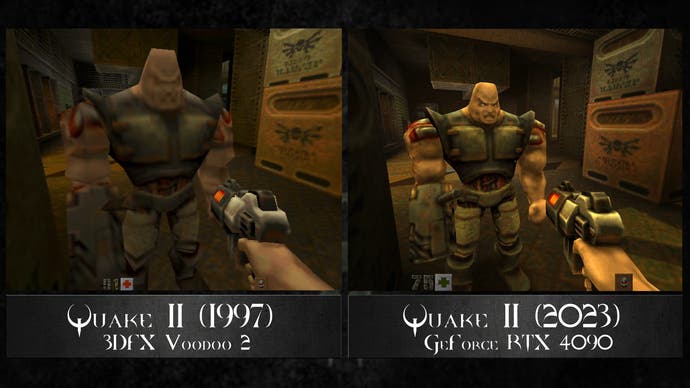
Combined, these features - and others we haven't mentioned - provide a substantial upgrade to the 2023 release's visuals. The new version of the Quake engine is also notable in supporting both DirectX 11 and Vulkan, rather than OpenGL. This new version also no longer uses binary space partitioning or BSPs, as levels are now broken up into cells instead to speed up geometry gathering for shadow maps and rendering. Sam came up with a pseudo-bindless texture solution that greatly reduces the number of draw calls and improves CPU performance, which was especially important on Switch.
While these features are all fantastic, the most significant visual improvement in my opinion comes from the reworked assets. Specifically, the game now supports the skeleton-based MD5 model format. In the original game, which uses the much older MD2 model format, vertex information is stored as individual bytes, which reduces file size, but also reduces precision. With low vertex precision, models such as weapons and enemies exhibit noticeable warbling when in motion. These original MD2 models are still present in the 2023 version if you choose, but the new MD5 skeleton-based models have all been completely reworked and improved, offering both additional detail and newfound stability thanks to increased precision.
This is perhaps most noticeable on the player's weapon - these large weapon models fill the player's view, but the lack of precision means they're constantly wobbling in the original game. Every weapon in the 2023 version has been redesigned, with an increase in both texture and geometry detail while maintaining the original aesthetic. It still feels appropriately 1997 and right at home in Quake 2.
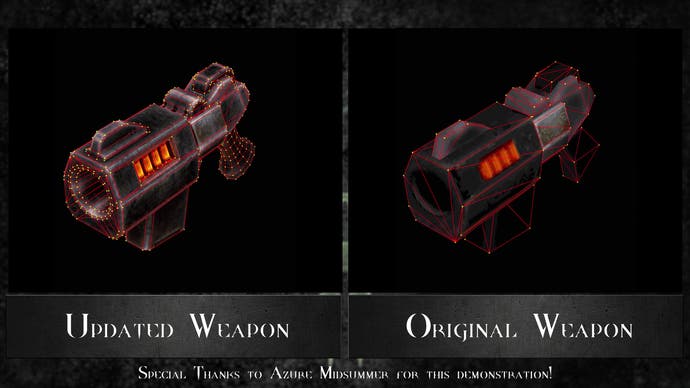

It's not just the dynamic objects that have received a boost either. Artists have combed through every level and added additional geometric flourishes where appropriate. Without comparing the two, you might never have guessed that anything had changed, but these extra details are welcome and enhance the presentation in my view.
Even better, the team uncovered unfinished map data in the id archives and restored areas that didn't exist in the shipping game, even including a whole new area in the opening level. For longtime Quake 2 fans, it's a real treat to discover new areas hidden within the game.
One last visual feature is the intro movie, which was rendered at a very low resolution and is hard to parse. For this re-release, Brendan McKinney went back and remade all of the game's FMV sequences from scratch, rendering them out as higher resolution videos. Considering that everything here was basically eyeballed and recreated, I'd say he did a remarkable job. Even the intermission screens both for the main game and the two mission packs have been entirely remade and look great. No matter which version you play then, there's a lot of love poured into the new presentation.
The 2023 version of Quake 2 changes more than just visuals too - enemy behavior, animation and even audio have all been modified. Furthermore, new features such as split-screen have been added to the mix.
It turns out, due to changes late in development, the original AI being planned for Quake 2 was never finished and only a simplified version was used in the final game. Thanks to the id archives however, these cut behaviours and improved path-finding have been added to the game. Enemies can now perform actions, such as jumping down from ledges or across chasms, delivering unexpected attacks in the process. The AI can now navigate more complex rooms, climb stairs, follow you through doors and more. By traversing multiple rooms and finding novel ways to get to you, it really mixes things up.
Then there's audio - this new release supports more simultaneous voices, reverb and increased flexibility regarding room size and materials - so footsteps sound different on different surfaces and change based on the size and type of environment you're in. The original soundtrack also makes a return, including new tracks created for the expansion packs and the N64 version of Quake 2.
There's also co-op and deathmatch, which in my testing worked well, with fast and responsive netcode even when playing against foes in different regions. Split-screen multiplayer with up to eight players is also included on Xbox and PC - which I wanted to test but didn't due to time constraints and a lack of controllers. Eight-way split-screen is unfortunately not possible on PlayStation platforms, due to each controller technically acting as two Bluetooth devices - one for controls, the other for sound - so the max is four here instead. Gamepad aiming is surprisingly great on all platforms though, and there are new quality-of-life features like an optional compass to point towards your next objective.
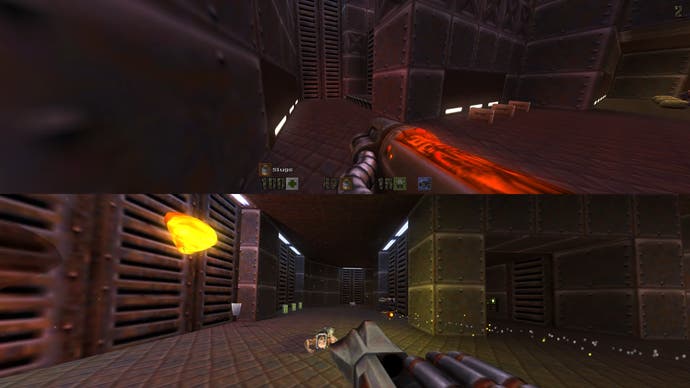
The single biggest reason to check out this new version of Quake 2, however, might just be the new campaign from Machine Games, the team behind the recent Wolfenstein titles and a long-time maker of Quake maps. If you want to see what this engine can achieve with the power of modern technology, look no further. The maps from the new camapign are gigantic, far larger than anything in Quake 2 proper, and the level of detail is so much higher. It's just packed with intricate geometry and towering structures. The level designs are also extremely nuanced and enjoyable to explore.
What's especially wild is the number of enemies thrown at the player. In the 90s, one of the issues with shifting to a polygon engine is that each enemy has a significant cost in terms of rendering budget, but on modern machines, all that goes out the window and these stages have enemy counts rivalling the original Doom - tons of foes flood the scene on a regular basis, leading to absolute chaos. This mission pack is so good that it could easily have been sold as a standalone game. Seriously, this is a masterclass in Quake 2 level design.
Of course, the addition of Nintendo 64 version of Quake 2 is also welcome. If you weren't familiar with it, this wasn't just a port - it was a wholly original Quake game with a completely novel campaign and additional multiplayer levels... and all of that content has made its way into this new version of Quake 2. That said, I do have one criticism: the 2023 release doesn't duplicate the tri-point texture filtering of the N64 original, as was the case in Nightdive's Doom 64 conversion.


The one caveat I might raise in all of this is that there are some minor changes in the 2023 release that may not appeal to everyone. The machine gun no longer has recoil, for instance, and speed running, I'm told, is no longer possible due to changes in some of the maps. The way exploding barrels work has changed - there's now a delay before they explode - and the crosshair is now accurate, with shots in the original release originally being slightly off-centre.
There are also some actual bugs, including keyboard and mouse support on consoles. You can play the game this way using USB peripherals, but in the current version the keyboard stops functioning after a few minutes, requiring you to re-insert the USB cable, rendering it essentially unplayable on both Xbox and PlayStation. There are at least gyro controls on Switch and PlayStation, though as an infrequent gyro aimer I can't judge whether this is a particularly good implementation or not.
Still, the overall feeling is that the 2023 version of Quake 2 is extremely well-made, faithful to the source material and well worth the $10 purchase price - and you can also get it as a free upgrade for Steam and GOG owners of Quake 2 or on Game Pass.
I had a great time revisiting Quake 2 once again, despite playing it off and on for the past 25 years, and I feel anyone that enjoys shooters and hasn't played Quake 2 needs to give it a shot. At the very least, it's an important piece of gaming history that should be experienced by all.










